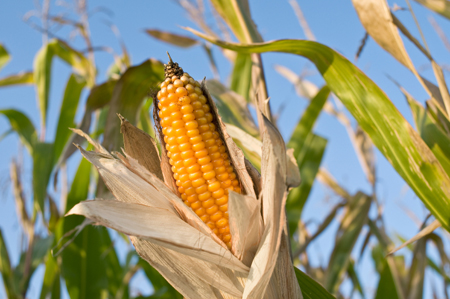 (Agrimoney) – A weaker dollar helped.
(Agrimoney) – A weaker dollar helped.
As did Chinese trade data. The country’s exports grew 15.3%, year on year, last month, beating expectations for a 12% increase, and the August figure of 9.4%.
Imports by the country, a huge buyer of commodities, grew by volumes 7% in September, ahead of forecasts of a 2% figure, and reversing the 2.4% fall registered in August.
Whatever, agricultural commodities opened the week largely firmer, with cotton, for instance, of which China is the top importer, adding 0.8% to 64.64 cents a pound in New York for December delivery as of 09:30 UK time (03:30 Chicago tim).
That extended gains after the US Department of Agriculture, in its much-watched Wasde crop report on Friday, cut its forecast for domestic stocks at the close of 2014-15 by 300,000 bales to 4.90m bales, with the downgrade reflecting lower production expectations.
More upgrades to come?
In Chicago, corn futures, which were pummelled in the last session after the USDA raised its forecast for the US yield by 2.5 bushels per acre to 174.2 bushels per acre, an even bigger record high, recovered 0.2% to $3.34 ½ a bushel.
In fact, the yield upgrade was less than expected, and initially provoked a rise in futures, before they plunged to close down 3% on ideas that the figure represents only a staging post on the way to a higher final result.
“The trade is already anticipating a higher US corn yield for the November report,” said Terry Reilly at Futures International.
Richard Feltes at RJ O’Brien said: “I suspect other analysts will affirm higher row crop yields, and lower corn use, than the USDA.
“There is nothing in the report that would encourage end-users to extend forward coverage.”
Tardy harvest
One popular reason cited for potential inaccuracy in the Wasde is that, as far as input from actual harvest results go, it is based on only the very early cuts, given the lagging harvest progress.
“Remember, we didn’t even have 15% of the soybean or corn crops harvested in the first week of October. So they use the date they had at that time,” Darrell Holaday at Country Futures said.
“We feel the corn yield will move at least above the 177-bushels-per-acre, number and quite likely hit the 180 level by the end of January,” when the USDA unveils final estimates.
“We expect the soybean yield will push the 50-bushels-per-acre level by January,” he added.
‘Rains will stall harvesting’
That said, it should also be remembered that results from the early harvest have been termed by many commentators as particularly mammoth, and not representative of the results coming in from the western Corn Belt.
(Not that these are regarded as at all poor, but merely strong rather than gargantuan.)
Furthermore, on the demand side, there was the 1.48m-tonne sale of US corn to Mexico announced on Friday to recall, which caused very little movement at the time, being unveiled just ahead of the Wasde.
And the US harvest remains slowish, delayed in part as a knock-on effect of a delayed sowing season and cool summer, but also by ongoing rains.
“Rains will be widespread today and tomorrow, with a few lingering showers possible on Wednesday,” said MDA, adding that the precipitation “will stall corn and soybean harvesting”, although drier weather is expected to kick in later this week.
‘Stressing corn and soybean germination’
Staying on weather setbacks, conditions speak of declining prospects for South American crops, according to MDA, although so early in the planting season such ideas should be taken with some caution.
In Argentina, “rains this week will maintain wetness and slow corn/sunflower planting”, the weather service said.
In Brazil, too little moisture is the issue, with weekend rains limited to Rio Grande do Sul, in the south, which will, with Santa Catarina, maintain something of a monopoly on precipitation in the country.
“Hot and dry weather over the next week in northern and central areas will allow soil moisture to decline further, stressing corn and soybean germination and early growth,” MDA said.
Soy gains
Indeed, soybeans for November rose too, by 0.6% to $9.27 ¾ a bushel in Chicago for November delivery.
Chinese imports of the oilseed last month came in at 5.03m tonnes, a little higher than the 4.98m tonnes that officials had expected, and up 7% year on year, if down 1m tonnes from the August figure.
Soybeans are also seen as more vulnerable to US harvest delays, in being more weather sensitive than corn.
Wheat rises
As for wheat, the outperformer of the last session, it maintained its grip on positive territory, adding 0.3% to $4.99 ¾ a bushel in Chicago for December delivery.
The grain was helped in the last session by a surprise downgrade to the USDA estimate for US stocks at the close of 2014-15, by 44m bushels to 654m bushels, reflecting in the main a cut by 29m bushels to 162m bushels to the forecast for soft red winter wheat, the type traded in Chicago.
Not that an increase to the US export forecast behind this downgrade has not been a little controversial.
‘We really question that increase’
“We are not as optimistic as the USDA on US wheat use, seeing lower exports and feed use,” said Richard Feltes at RJ O’Brien, suggesting a carryout stocks figure nearer to 700m bushels.
Darrell Holaday at Country Futures said: “We really question that increase”, in the export estimate.
At Benson Quinn Commodities, Jonathan Watters said: “Wheat appears to be a firming market, with momentum turning and the Wasde report confirming that the demand picture has increased after last month’s lows.
“But it remains to be seen just how strong wheat can remain with a massive corn harvest in full swing.”




